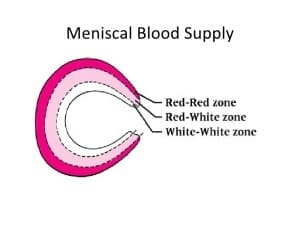Meniscus tears are one of the most common injuries in sports and lead to a lot of time out from sports, swelling and pain. Here is what you can do to help your knee heal strong and fast and even avoid surgery.
Meniscus tears are, without a doubt the most common injury in the knee and the 5th most common injuries that present to sports medicine clinics.(1) With this in mind, we think it is important that you know:
- What the meniscus is and how they get injured
- What is better surgery or physio?
- What are the best exercises you can do at home to heal strong and fast.
So let’s cover these three…
What is the meniscus:
There are two meniscus in each knee, which are horseshoe-shaped and thicker on the outside to give a nice cup for your thigh bone to sit in.
These give stability for your knee by adding a cup for the thigh bone to sit in and guiding the joint as it moves.
The meniscus also offer some padding between the two bones.

Only the outer 3rd of the meniscus has blood supplied to it, meaning in general healing can be slow for meniscus, particularly in the inner 3rd where there may be no healing response.
In general, allow 12 weeks healing for meniscus tears.
How does Meniscus get injured:
Meniscus tears often happen with combined twisting and flexion, such as when you land and pivot on your leg after catching a ball or step out of the car and twist at the same time.
Think of it like this; Your meniscus sits between your shin and thigh bones. If your foot is planted on the ground and you are turning your body and pivoting way, this puts a huge amount of torsion through the meniscus.
This combined with you body weight can often lead to a meniscus tear in many fast-moving ball sports – Makes sense right?
Common symptoms to look out for:
- Pain on either the inside (more common) or outside of the knee-joint
- Swelling, often a lot above the kneecap
- Popping, clicking and catching
- Locking of the knee joint, indicates a significant meniscus tear
What is the best treatment approach?
There are two main approaches for meniscus tear
- Surgical repair via arthroscopic surgery
- Physiotherapy and Strengthening Exercises – a more conservative treatment
Surgery vs Physiotherapy
There was a groundbreaking study done in 2002 which really made a lot of health professionals and surgeons take note.
They took a group of patients with degeneration in their knees (arthritis) and split them up so that some of them had arthroscopic surgery, but some of them just got incisions in their skin so that it looked like they had surgery. The outcomes between the groups were no different.(3)
Since then a lot of further studies have been done, looking at meniscus injuries and whether surgery is better than conservative rehab and this is what they found:
- There is no significant difference in functional outcome between Physio and surgery (4)
- For degenerative meniscus tears, there is no difference between surgery and placebo (5)
- Arthroscopic surgery and strengthening is no better than strengthening alone in degenerative meniscus tears (6)
Conclusion – Physiotherapy is the Answer
We really need to split meniscus tears into 2 groups; there are degenerative tears which are due to wear and tear and then there is acute meniscus tears which occur from one accident/incident.
Degenerative Meniscus Tears
We can safely say that for degenerative mensicus tears, surgery is not the answer and should be looked at only if conservative rehab fails
Even the American Academy of Orthopaedic Surgeons state: “We are unable to recommend for or against arthroscopic partial meniscectomy in patients with osteoarthritis of the knee with a torn meniscus.”(7)
Acute Meniscus Tears
When it comes to acute meniscus tears though, it gets a bit more complicated. Surgery definitely can help here, but as a general rule, only if there is:
- Instability – Knee giving way and you can’t trust it
- Locking up
- Or if conservative rehab does not have good results after 6-12 weeks.
So if you have a meniscus tear, whether degenerative of acute and have no instability or locking up, then the best thing for you is to get onto a good rehab and strengthening program and give it a good shot before jumping to the scalpel.
Follow this link for the second post in the series which details a simple home-exercise programme for you to follow.
